

The famous faces in rock
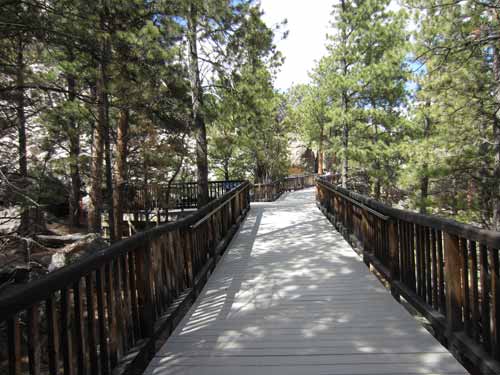
The Presidential Trail

Better down than up!

So, who are these men?...

George Washington - 1st president (1789 - 1797)
Born in 1732 in Westmoreland County, Virginia; Married Martha Dandridge Custis. They raised two children from her first marriage (two others had died); Led the American revolution against the British; Died in 1799 at Mount Vernon, Virginia

Washington receiving a salute on the Field of Trenton

Thomas Jefferson - 3rd president (1801-1809)
Born in 1743 in Shadwell, Virginia; Married Martha Wayles Skelton. They had 6 children (one died at birth; two died at the age of 1, one died at 2; and one at 26). Martha died at the age of 34 (several months after the birth of her last child). This had been her second marriage as her first husband had died young; Purchased the Louisiana Territory from France for $15 million; Died on July 4th, 1826 at Monticello, Virginia (on the 50th anniversary of the Declaration of Independence).

Jefferson

Abraham Lincoln - 16th president (1861-1865)
Born in 1809 in a log cabin in Hardin County, Kentucky; Married Mary Ann Todd. They had 4 children (only one outlived her); Ended the Civil War; Died in 1865, shot at Ford's theater, Washington D.C.

Lincoln with his wife

Theodore Roosevelt - 26th president (1901 - 1909)
Born in 1858, New York City; Married twice (Alice Hathaway Lee and Edith Kermit Carow) with 6 children; First president to travel outside the US; Died in 1919 in Oyster Bay, New York
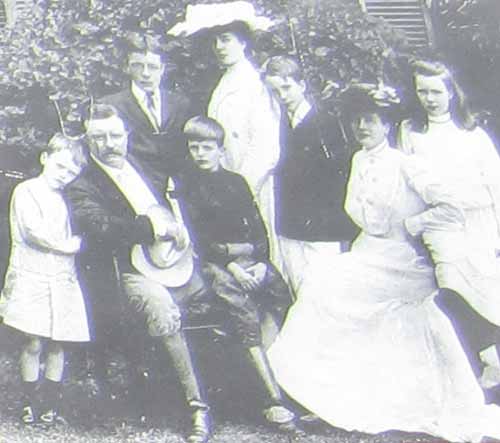
With his family

As close as we could get

The detail of the rock...

... and the ingenuity of the carving.

Not just closed... but Federally closed
We then entered the Sculptor's Studio, where we learned about the history and the making of the massive carving. A ranger was demonstrating the equipment that was used to carve the mountain. After his talk, we walked around looking at some of the exhibits. There were more exhibits down at the visitor museum.
The Mount Rushmore National Memorial was sculpted by Danish-American Gutzon Borglum. Originally it was the idea of Doane Robinson, a South Dakota historian, in order to promote tourism in the region. He, however, had suggested western heros, such as Buffalo Bill Cody, Lewis and Clark, and Red Cloud. He had also suggested using some nearby rock pillars called the Needles. However, Borglum chose Mount Rushmore because of its higher quality of granite. It also faced southeast for maximum sun exposure. Borglum also felt it should have more of a national focus.


Originally known to the Lakota Sioux as Six Grandfathers, the mountain was renamed after Charles E. Rushmore, a prominent New York lawyer, during a prospecting expedition in 1885.
After securing federal funding, construction on the 60-foot tall (18 meters) sculptures began in 1927, and the presidents' faces were completed between 1934 and 1939. Upon Gutzon Borglum's death in March 1941, his son Lincoln Borglum took over construction. Although the initial concept called for each president to be depicted from head to waist, lack of funding forced construction to end in late October 1941.
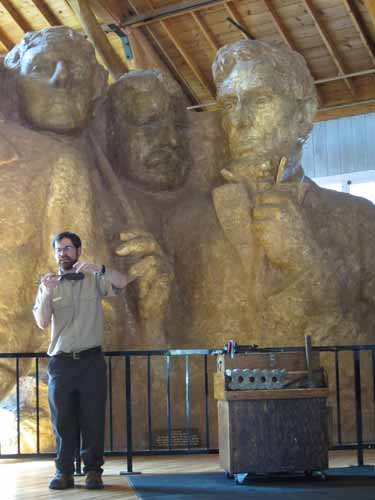
Behind the ranger is a scale model, where one inch = one foot. This was the last model made by Boglum in 1936, midway through the construction process. Notice how the sculpture goes down to the men's waists. Plans changed many times due to the variation in the rock formation... and mistakes.

The ranger demonstrates the protractor plate and plumb bob (old technology borrowed from the ancient Egyptians) ....

... while another ones hangs down from Lincoln.
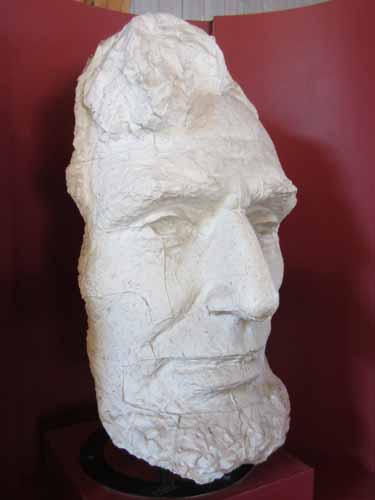
Plaster masks of the presidents were hung from cables and used by the workers for visual comparisons and measurements....

... The mask in action.

The figures are scaled to the height of a person 465 feet tall... just shy of the pyramids.

Hand-driven winches, each operated by two workers, were installed in "winch houses" at the top of the mountain. Cables, attached to the winches, lowered tools, equipment and workers in bosun chairs to various locations on the sculpture.

A bosun chair

An old drill with pieces
Over 450,000 tons of rock were removed.... 90% by dynamite, the rest (the last 2 - 3 inches) by drilling with jackhammers and wedging the rock off the cliff face. The final finishing work was completed using small jackhammers and facing bits.


Drilling... (a drill bit would only last 30 minutes due to the extremely hard granite. The workers went though 400 bits per day. There had to be a blacksmith on site in order to continually make and sharpen them)...
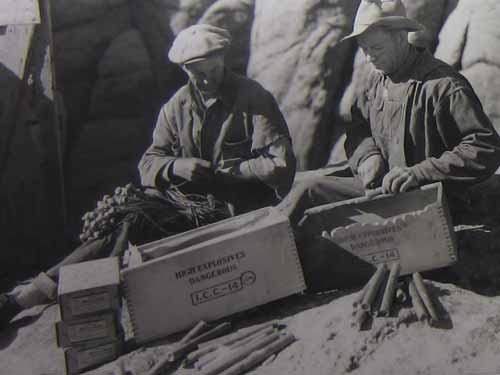
... and dynamiting came first.

This was a cute exhibit where you could do your own blasting. By selecting a button, then pushing down the handle, a movie would play showing different pieces being blasted off. Apparently blasting was done twice a day: once at lunch and once at the end of the day.

Air compressors located at the base of the mountain provided power to operate the jackhammers. An 1,800-foot, 3-inch pipeline followed the stairway up the mountain to carry the air. In cold weather, a liquid gas was injected as a fine mist into the pipeline to prevent freezing.
In 1936, a National Park Service engineer inspected the system. He discovered that the blacksmith had tapped a small nozzle into the line to blow compressed air on himself while he worked!
He also discovered the reason for a large power loss every Monday. Apparently, Monday was laundry day for all the women in Keystone, and many of them had electric washing machines. So they bought a gasoline-powered auxiliary compressor. Not only did that solve their power problems, it also increased the number of jackhammers that could be operated from 16 to 22.

Next came honeycombing. A worker would drill shallow holes close together. This weakened the rock so precise amounts of granite could be removed.
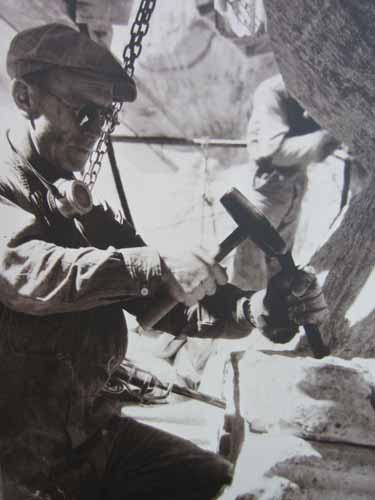
A hammer and chisel were used to break off the honeycomb.

After drilling, dynamiting, and honeycombing the rock, workers used bumper tools to smooth the surface to give the sculpture its soft look.

Borglum inspects the work.
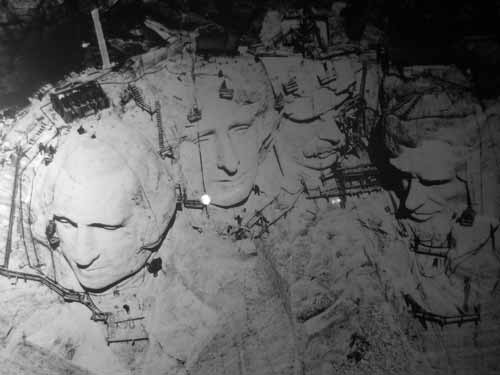
The carving required a small village on the mountain top... the winch house, a repair shop for tools, sheds to store dynamite, shelter from sudden storms, the landing for the tram car, etc.

While most workers took the over 700 stairs to the top of the mountain each day, others rode in "the bucket." Originally just used to carry tools and supplies, the cable tram car was enlarged in 1936 to carry passengers.
Amazingly enough, with 400 workers over the course of 14 years, there was not a single fatality and no major injuries. We watched a short film where one of the workers (in his 80's or so) relived a scary moment. He was heading down in the bucket with 3 other workers. Suddenly something went wrong and the bucket started speeding down the cable line. The men couldn't decide whether to jump or stay in. He decided to jump (aiming for the roof of one of the buildings) while the others stayed in. They ended up being fine and he ended up with a broken leg!

The stairs! Workers only got paid for when they worked. Climbing up and down these stairs was on their own time!

Jefferson was initially started to Washington's right, but poor quality of rock forced them to blast away this first attempt in 1934.
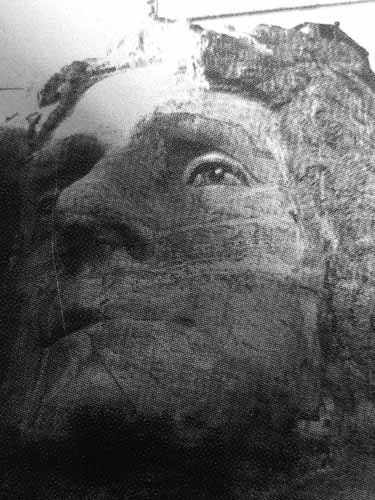
He again caused problems when a hole was accidentally blasted in his forehead. Originally higher than Washington, he now had to be moved lower. But then due to a major crack in the granite, he had to be carved looking slightly up instead of straight. The project was continually changing.

Yet another version. There were so many different possibilities. Do they portray Lincoln with or without a beard? Jefferson was portrayed at age 33, before he became president but when he drafted the Declaration of Independence.

Another idea was to add something commemorating the Louisiana Purchase...
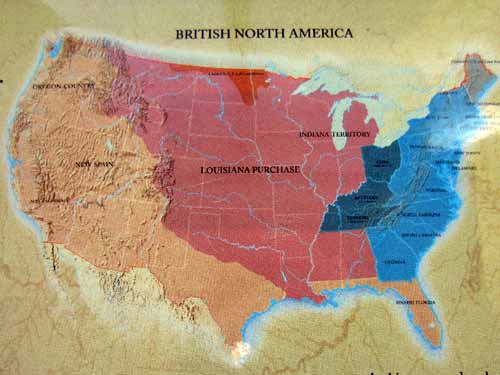
... which (as you can see) vastly increased the size of the country.

Original plans included a hall of records carved behind the monument. It was intended to be a large room which would contain the country's greatest documents....

... While funding ran out before it could be fully built, a small room was still made. Note the small door to the right with stairs leading up.

Back then, cracks in the rock were repaired using linseed oil, white lead and granite dust. Today, silicone is used. There are currently 144 cracks in Mt. Rushmore.

